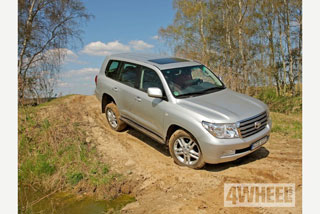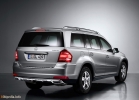Test drive Mercedes Benz GL-class X164 since 2009 SUV
Comparative review of the Toyota Land Cruiser 200 and Mercedes-Benz GL diesel engineers
 With both these ships of the dream, you can literally become huge. Creating these giants, Toyota and Mercedes did not stint on dimensions and luxury. Comparison of incomparable.
With both these ships of the dream, you can literally become huge. Creating these giants, Toyota and Mercedes did not stint on dimensions and luxury. Comparison of incomparable. Next to these giants, even Jeep Wrangler seems small. Smart looks like it can be parked in the luggage of Land Cruiser V8 or Mercedes GL. Whoever wants a larger car is worth a closer look at Unimog. Moreover, GL and Land Cruiser attract attention not only with their large sizes: both representatives, of course, are at a high level in areas such as luxury and power. V8 diesel engines with a large volume and even various bells out of the ventilation of seats to the television antenna, if necessary, in these cars you can live in the apartments.
It is hardly a question of money when choosing a car of this class, but, nevertheless, Toyota dealers want to see almost 70,000 euros for a start, and Mercedes sellers ask at least 84,000 euros before one of these cars appear in front of the buyer door . Thus, the game unfolds within the S-class and BMW 7th series. But Mercedes becomes true Benz only when the declared basic value is only the beginning of a long trip along a long list of options for GL on 28 pages. Indeed, while for the most expensive Land Cruiser Excutive configuration, only three options are offered for an additional fee (the third row of seats, a system with a DVD player for the rear seats and a more expensive audio system), the GL buyer is practically the right to independently equip his car. For the options that you need to buy for this class, for example, a DVD navigator, leather finish or painting in the color of metallic, you will have to lay out the cost of a round-the-world trip. And for Land Cruiser, all this is included in the standard of configuration. The fact that for such a Mercedes, you need to pay separately for the rear lateral airbags, also seems to be awkward.
The new eight -cylinder Toyota diesel has an advantage in volume of as much as 460 cubic meters. Nevertheless, eight half-liter pots give Mercedes more power. And at the twisting moments of Swabia, the leader is again. But these are, rather, scientific comparisons or cases for disputes at the table, since with its 286 horsepower and 650 Nm Land Cruiser does not really feel the need for anything. And yet, according to the characteristics of the Mercedes movement, ahead. Of course, the 4.5-liter Toyota engine throws a giant forward with such an onslaught that for a split second you are worried about the rotation of the earth. But the smaller V8 Mercedes makes it even more powerful. In eight seconds from zero to 100 km/h, in seven seconds from 80 km/h to 120 km/h and all this with a live weight of almost 2.7 tons. Here, in surprise, even drivers of proven sedans of the highest class rub their eyes when this elephant begins to move along the autobahn.
Such a force cannot do in vain. After all, even in the content of both cruisers, a far from a skinny wallet will be required. In normal management mode, the consumption will not become lower than 13 liters, when receiving payments on CASCO, strong nerves will not interfere, and as for the loss of value, the buyer will have to realize that in three years his car will no longer be equivalent to the Land Rover Freelander.
However, it is simply amazing how much our participants differ in behavior, despite similar main characteristics. Speaking briefly: even in the comfort mode established for pneumatic suspension, Mercedes is more quick than Toyota, the suspension switch of which is at the Sport mark. GL slowly leans to the side, if you pass the turns quickly, the Toyota in such cases has an even larger roll.
To this, you need to add inaccurate control and completely non -consistent with this price and power category of the brake system (the first tuners have already paid attention to this problem). While driving Toyota, the driver after a few kilometers voluntarily monitors the readings of the navigator and uses the existing power only for overtaking. But on a long trip, when you rush towards the horizon, on the contrary, there is nothing better than the Toyo giant, which you can relax with. Mercedes is controlled very accurately and even at high speed along the autobahn inspires a sense of confidence.
On off -road, the serial GL uses the full range of SUV equipment on the ML/GL platform: a pneumatic suspension adjustable in height, blocking the differential of the rear axle, as well as the drive control system and the descent assistance system. Toyota also has all this, in addition, it can benefit with the use of her soft suspension on the off -road. It is much better springy and due to the smoothness of the course, it works excellently with fast drum driving. In contrast to the pneumatic suspension of Merdcedes, Toyota uses hydropneumatics, the elements of which are interconnected. Thanks to this, the stroke of shock absorbers improves, since the failing wheel simultaneously raises the opposite wheel.
If we consider the use of cars as a school bus, a car for transporting furniture or a tractor, then it is very difficult to give preference to one of the competitors. For both, the third row of seats is available in the form of the option, with Mercedes, additional seats are equipped with an electric drive, and there is enough free space in front of them even for adult passengers. The cars have approximately equal volume of the luggage compartment and the permissible load. In addition, both the German and the Japanese can easily carry a 3.5-ton trailer.
The differences in terms of interior are more remarkable. The Land Cruiser panel does not differ in ergonomicity by either a completely arbitrary division of switches into different groups, nor the transfer of individual functions to other panels is not very clear. Mercedes allows you to do all this one or two switches. Finally, the impression of the design of the cockpit depends on your taste. In Benz, almost everything reminds of a cheaper M-class, in Toyota something makes you remember Rav4 or the Land Cruiser of the 120th series. But in terms of the quality of decoration, cars are not inferior to a friend in a friend, in this price category, you can rightly count on a high -quality materials pleasant to the touch.







Main characteristics
Mercedes Toyota
Model GL 420 CDI Land Cruiser 4.5 V8 D-4D
Release date 09/2006 03/2008
Basic value 85.442 euros 82.300 euros
V-shaped motor type V-shaped
Number of cylinders 8 8
Engine volume 3996 cm 4461 cm
Power 306 hp (225 kW) at 3600 rpm 286 hp (210 kW) at 3600 rpm
Torque 700 nm at 2000 rpm 650 nm at 1600 rpm
Environmental friendliness Euro-4 Euro-4
Extrication CO2 307 gr/km 270 g/km
The transmission is automatic
Number of programs 7 6
Michelin Diamaris Dunlop Grandtrek
Front tires 275/55 R19 V 285/50 R20 V
Front discs 8.5 j x 19 9 j x 20
Rear tires 275/55 R19 V 285/50 R20 V
Rear discs 8.5 j x 19 9 j x 20
The weight
Own mass 2605 kg 2803 kg
Permissible load 645 kg 497 kg
Point load 750 kg 750 kg
Point load (with brakes) 3500 kg 3500 kg
Dimensions
Length 5088 mm 4950 mm
Width 1920 mm 1970 mm
Height 1840 mm 1865 mm
Wheel base 3075 mm 2850 mm
Front track 1645 mm 1640 mm
Rear track 1648 mm 1635 mm
The diameter of the turn on the left is 12.4 m 13.2 m
The diameter of the turn on the right is 12.3 m 13.2 m
Inner dimensions
The luggage compartment volume is 2300 - 620 l 2320 - 655 l
The width of the salon in front is 1515 mm 1625 mm
The width of the cabin behind 1510 mm 1625 mm
Salon height in front 1035 mm 970 mm
The height of the cabin behind 1015 mm 985 mm
Front seats depth 495 mm 480 mm
The depth of the rear seats is 495 mm 500 mm
Planting space 645-915 mm 700-925 mm
Standard landing space 745 mm 780 mm
Acceleration
0-100 km/h (manufacturer data) 7.6 with 8.2 s
Maximum speed 230 km/h 210 km/h/hour
Braking (from 100 to 0 km/h)
Braking distance with cold brakes with a load of 38.6 m 40.6 m
Braking distance with hot brakes with a load of 38.6 m 48.8 m
Fuel consumption
Diesel Diesel fuel type
Minimum (on the test track) 10.3 l/100 km 10.0 l/100 km
Maximum 17.0 l/100 km 17.5 l/100 km
Consumption during a test 15.2 l/100 km 15.4 l/100 km
City cycle (off. Data) 15.6 l/100 km 12.0 l/100 km
Country cycle (off. Data) 9.2 l/100 km 9.1 l/100 km
Mixed cycle (off. Data) 11.6 l/100 km 10.2 l/100 km
Price
Basic cost 85,442 euros 82 300 euros
Fixed expenses
Tax 617.60 euros 694.80 euros
Partial CASCO 1,119.84 euros 1,119.84 euros
Full CASCO 5 861.31 euros 5 861.31 euros
Other expenses
Operational costs for 100 km 23.15 euros 31.42 euros
Maintenance costs per month
with a run of 15,000 km/year 46.68 euros 58.74 euros
Source: 4wheelfun.de








